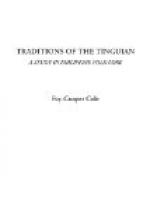Comparison of the Reconstructed Culture with Present Day Conditions.—Before passing to a consideration of the tales in the last two divisions of our material, it may be well to compare the life and beliefs of these “people of the first times” with those of the living Tinguian. Kadalayapan and Kaodanan appear, in a vague way, to have been located in Abra, for we learn that the Ilocano, Don Carlos, went up the river from Baygan (Vigan) [43] to Kadalayapan; that the alzados [44] lived near by; while the tattooed Igorot occupied the land to the south (pp. 77, 155). The villages were surrounded by defensive walls such as were to be found about all Tinguian villages until recent times, and which are still to be seen about Abang and other settlements. Within the walls were many houses, the descriptions of most of which would fit the dwellings of to day. The one thing which seems foreign to present conditions is the so-called “ninth room” which receives rather frequent mention. There is nothing in the tales referring to buildings or house construction which lends support to the contention of those who seek to class the Tinguian as a modified sub-group of Igorot. [45] The Bontoc type of dwelling with its ground floor sleeping box and its elevated one room kitchen and storage room is nowhere mentioned, neither is there any indication that in past or present times the Tinguian had separate sleeping houses for the unmarried men and boys, and for the girls, as do their neighbors to the south.
The other structures, such as the spirit houses, rice drying frames, and granaries were similar to those seen to-day in all the villages. Likewise the house furnishings, the musical instruments, and even the games of the children were such as are to be found at present, while our picture of the village life given on page 9 still fits nearly any Tinguian settlement in Abra. The animals mentioned are all familiar to the present people, but it is worthy of note that in the first twenty-six tales, which make up the cycle proper, the horse is not mentioned, nor does the carabao appear to be used as a work animal. Still more important is the fact that the terraced fields and the rice culture accompanying them, which to-day occupy a predominant place in the economic life of the people, are nowhere mentioned. On the other hand, the langpadan, or mountain rice, assumes a place of great importance. References to the cultivation of the land all seem to indicate that the “hoe culture,” which is still practiced to a limited extent, took the place of agriculture.
The clothing, hair dressing, and ornaments, worn by these people, agree closely with those of to-day. Beads seems to have been of prime importance, but could scarcely have been more prized or more used than at present. Unless she be in mourning, the hair and neck of each woman are now ornamented with strings of beads, many of them of evident antiquity, while strands above strands cover the arms from the wrist to the elbow or even reach to the shoulder. [46]




